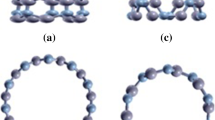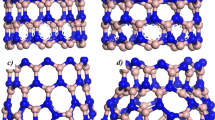Abstract
Single-, double-, and triple-walled beryllium oxide nanotubes (BeONTs) along with BeO nanopeapods were simulated and geometrically optimized under the density functional theory (DFT) framework to investigate their Young’s modulus, electronic properties, and stability. We found better properties in single-walled nanotubes, either their electronic or mechanical properties, than other mentioned nanotubes. Increase in the radius and inter-wall distance made an overall decrease in the Young’s modulus of SW and DW BeONTs. The highest obtained modulus of SWBeONTs and DWBeONTS was calculated for structures (14,0) and (8,0)@(14,0) with the magnitudes of 700.12 Gpa and 712.24 Gpa, respectively. In addition, increasing the wall number from one to two resulted to significant growth in Young’s modulus of DWBeONTs while created no significant difference between DWBeONTs and TWBeONTs. Bandgap energy of single-walled nanotubes was higher than those of double- and triple-walled nanotubes, and the bandgap showed consistent soar in both SW and DW BeONTs via increase in the radius and inter-wall distance, respectively. Furthermore, considering nanopeapods with various interlayer distances revealed that the Young’s modulus and energy gap behavior of these structures were similar to what we observed in SWBeONTs. However, nanopeapods showed weaker mechanical and semiconducting properties compared with SWBeONTs. Moreover, calculating the formation energies of all under consideration structures revealed a reduction of formation energy via an increase in the dimension of single-walled nanotubes, an increase in the dimension of nanotubes via adding more walls, and an increase in the dimension of peapod structures as well, and the bigger structures are more stable than smaller ones.














Similar content being viewed by others
References
Iijima S, Ichihashi T (1993) Single-shell carbon nanotubes of 1-nm diameter. Nature 363(6430):603–605
Ivanovskii AL (2002) Non-carbon nanotubes: synthesis and simulation. Russ Chem Rev 71(3):175–194
Lieber CM (1998) One-dimensional nanostructures: chemistry, physics & applications. Solid State Commun 107(11):607–616
Rathi SJ, Ray AK (2008) On the existence and stability of single walled SiGe nanotubes. Chem Phys Lett 466(1):79–83
Marana NL, Casassa S, Longo E, Sambrano JR (2018) Computational simulations of ZnO@GaN and GaN@ZnO core@shell nanotubes. J Solid State Chem 266:217–225
Samadipakchin P, Mortaheb HR, Zolfaghari A (2017) ZnO nanotubes: preparation and photocatalytic performance evaluation. J Photochem Photobiol A Chem 337:91–99
Setoodeh A, Attariani H, Jahanshahi M (2011) Mechanical properties of silicon-germanium nanotubes under tensile and compressive loadings. J Nanopart Res 15:105–114
Kim DE, Pak D (2019) Ti plate with TiO2 nanotube arrays as a novel cathode for nitrate reduction. Chemosphere 228:611–618
Zhao H, Yang C, Li N, Yin J, Feng Y, Liu Y et al (2019) Electrical and mechanical properties of polyimide composite films reinforced by ultralong titanate nanotubes. Surf Coat Technol 360:13–19
Satish G, Prasad VVS, Ramji K (2018) Effect on mechanical properties of carbon nanotube based composite. Mater Today Proc 5(2, Part 2):7725–7734
Ganji M, Sharifi N, Ahangari MG (2014) Adsorption of H2S molecules on non-carbonic and decorated carbonic graphenes: a van der Waals density functional study. Comput Mater Sci 92:127–134
Ahangari MG, Fereidoon A, Jahanshahi M, Ganji M (2013) Electronic and mechanical properties of single-walled carbon nanotubes interacting with epoxy: a DFT study. Physica E 48:148–156
Hamed Mashhadzadeh A, Fereidoon A, Ghorbanzadeh Ahangari M (2017) Combining density functional theory-finite element multi-scale method to predict mechanical properties of polypropylene/graphene nanocomposites: experimental study. Mater Chem Phys 201:214–223
Fereidoon A, Mostafaei M, Ganji MD, Memarian F (2015) Atomistic simulations on the influence of diameter, number of walls, interlayer distance and temperature on the mechanical properties of BNNTs. Superlattice Microst 86:126–133
Dadrasi A, Albooyeh AR, Hamed Mashhadzadeh A (2019) Mechanical properties of silicon-germanium nanotubes: a molecular dynamics study. Appl Surf Sci 498:143867
Hao J-H, Wang Y-F, Yin Y-H, Jiang R, Wang Y-F, Jin Q-H (2015) An ab initio study of the size-dependent mechanical behavior of single-walled AlN nanotubes. Solid State Sci 45:30–34
Mashhadzadeh A, Fereidoon A, Ahangari M (2017) Surface modification of carbon nanotubes using 3-aminopropyltriethoxysilane to improve mechanical properties of nanocomposite based polymer matrix: experimental and density functional theory study
Hamed Mashhadzadeh A, Fathalian M, Ghorbanzadeh Ahangari M, Shahavi MH (2018) DFT study of Ni, Cu, Cd and Ag heavy metal atom adsorption onto the surface of the zinc-oxide nanotube and zinc-oxide graphene-like structure. Mater Chem Phys 220:366–373
Continenza A, Wentzcovitch R, Freeman AJ (1990) Theoretical investigation of graphitic BeO
Allouche A, Oberkofler M, Reinelt M, Linsmeier C (2010) Quantum modeling of hydrogen retention in beryllium bulk and vacancies. J Phys Chem C 114(8):3588–3598
Kiiko VS, Vaispapir VY (2015) Thermal conductivity and prospects for application of BeO ceramic in electronics. Glas Ceram 71(11):387–391
Fathalian A, Kanjouri F, Jalilian J (2013) BeO nanotube bundle as a gas sensor. Superlattice Microst 60:291–299
Chigo Anota E, Cocoletzi GH (2013) Electronic properties of functionalized (5,5) beryllium oxide nanotubes. J Mol Graph Model 42:115–119
Roozbahani GM, Seif A (2012) A computational NMR study of nitrogen substitutional impurity in the armchair BeO nanotube. Superlattice Microst 51(3):363–371
Yang L, Greenfeld I, Wagner HD (2016) Toughness of carbon nanotubes conforms to classic fracture mechanics. Sci Adv 2(2):e1500969
Davoodi J, Soleymani M, Sabet HA (2018) Thermal stability of single walled SiGe nanotube with vacancy defects: a molecular dynamics simulation study. Silicon 10(3):731–736
Allouche A, Ferro Y (2015) First-principles study of hydrogen retention and diffusion in beryllium oxide. Solid State Ionics 272:91–100
Shen H (2007) Compressive and tensile properties of Ar filled carbon nano-peapods. Mater Lett 61(2):527–530
Okazaki T (2014) Chapter 10 - preparation and properties of carbon nanopeapods. In: Tanaka K, Iijima S (eds) Carbon nanotubes and graphene2nd edn. Elsevier, Oxford, pp 225–252
Georgakilas V, Bourlinos AB, Ntararas E, Ibraliu A, Gournis D, Dimos K et al (2016) Graphene nanobuds: synthesis and selective organic derivatisation. Carbon 110:51–55
Hamed Mashhadzadeh A, Ghorbanzadeh Ahangari M, Dadrasi A, Fathalian M (2019) Theoretical studies on the mechanical and electronic properties of 2D and 3D structures of beryllium-oxide graphene and graphene nanobud. Appl Surf Sci 476:36–48
Yang X, Wang L, Huang Y, To AC, Cao B (2015) Effects of nanobuds and heat welded nanobuds chains on mechanical behavior of carbon nanotubes. Comput Mater Sci 109:49–55
Sohi AN, Naghdabadi R (2009) Stability of single-walled carbon nanopeapods under combined axial compressive load and external pressure. Physica E 41(3):513–517
Yu H, Xu L, Wang H, Jiang H, Li C (2019) Nanochannel-confined synthesis of Nb2O5/CNTs nanopeapods for ultrastable lithium storage. Electrochim Acta 295:829–834
Hohenberg P, Kohn W (1964) Inhomogeneous electron gas. Phys Rev 136(3B):B864–BB71
Kohn W (1999) Nobel lecture: electronic structure of matter---wave functions and density functionals. Rev Mod Phys 71(5):1253–1266
Ordejón P, Artacho E, Soler JM (1996) Self-consistent order-$N$ density-functional calculations for very large systems. Phys Rev B 53(16):R10441–R104R4
José M, Soler EA, Gale JD, García A, Junquera J, Ordejón P, Sánchez-Portal D (2002) The SIESTA method for ab initio order-N materials simulation. J Phys Condens Matter 14(11):2745
Perdew JP, Burke K, Ernzerhof M (1997) Generalized gradient approximation made simple [Phys. Rev. Lett. 77, 3865 (1996)]. Phys Rev Lett 78(7):1396
Monkhorst HJ, Pack JD (1976) Special points for Brillouin-zone integrations. Phys Rev B 13(12):5188–5192
Shahrokhi M, Leonard C (2016) Quasi-particle energies and optical excitations of wurtzite BeO and its nanosheet. J Alloys Compd 682:254–262
Jalilian J, Safari M, Naderizadeh S (2016) Buckling effects on electronic and optical properties of BeO monolayer: first principles study. Comput Mater Sci 117:120–126
Rastegar SF, Ahmadi Peyghan A, Soleymanabadi H (2015) Ab initio studies of the interaction of formaldehyde with beryllium oxide nanotube. Physica E 68:22–27
Sherafati M, Shokuhi Rad A, Ardjmand M, Heydarinasab A, Peyravi M, Mirzaei M (2018) Beryllium oxide (BeO) nanotube provides excellent surface towards adenine adsorption: a dispersion-corrected DFT study in gas and water phases. Curr Appl Phys 18(9):1059–1065
Memarian F, Fereidoon A, Khodaei S, Mashhadzadeh AH, Ganji MD (2017) Molecular dynamic study of mechanical properties of single/double wall SiCNTs: consideration temperature, diameter and interlayer distance. Vacuum 139:93–100
Vahedi Fakhrabad D, Shahtahmassebi N (2013) First-principles calculations of the Young's modulus of double wall boron-nitride nanotubes. Mater Chem Phys 138(2):963–966
Shakerzdeh E, Tahmasebi E, Shamlouei HR (2015) The influence of alkali metals (Li, Na and K) interaction with Be12O12 and Mg12O12 nanoclusters on their structural, electronic and nonlinear optical properties: a theoretical study. Synth Met 204:17–24
Wu C-D, Fang T-H, Chan C-Y (2011) A molecular dynamics simulation of the mechanical characteristics of a C60-filled carbon nanotube under nanoindentation using various carbon nanotube tips. Carbon 49(6):2053–2061
Asghari M, Naghdabadi R, Rafati-Heravi J (2011) Small scale effects on the stability of carbon nano-peapods under radial pressure. Physica E 43(5):1050–1055
Author information
Authors and Affiliations
Corresponding author
Additional information
Publisher’s note
Springer Nature remains neutral with regard to jurisdictional claims in published maps and institutional affiliations.
Rights and permissions
About this article
Cite this article
Rostamiyan, Y., Mohammadi, V. & Hamed Mashhadzadeh, A. Mechanical, electronic and stability properties of multi-walled beryllium oxide nanotubes and nanopeapods: a density functional theory study. J Mol Model 26, 76 (2020). https://doi.org/10.1007/s00894-020-4328-5
Received:
Accepted:
Published:
DOI: https://doi.org/10.1007/s00894-020-4328-5




